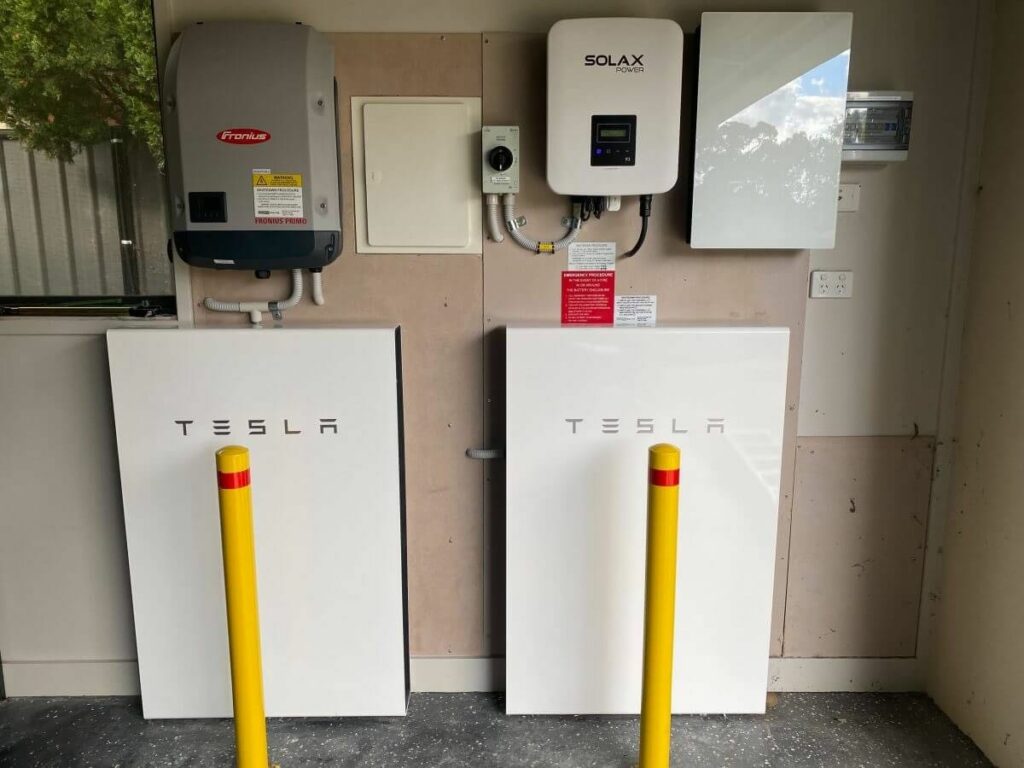Last update January 7th, 2025 at 12:25 pm
Solar battery storage or choosing a home battery system is about finding a battery that can store the energy produced by your solar panels. By doing so, you will be able to use the stored solar energy when your solar panel’s energy output is low or non-existent.
As you might know, solar panels produce electricity when they are exposed to sunlight. During the night or gloomy winter days, you can use energy from the battery to operate your home appliances.
Here is our beginner’s guide for everyone who is considering buying a solar battery!

First Of All: Do You Need A Solar Battery?
Not necessarily. Whether you will need a solar battery or not, depends on your solar panel system.
Stand-Alone Solar Systems
If you have a stand-alone solar panel system without a grid connection, a solar battery is necessary. Without a battery, your home will not have electricity during the night.
A stand-alone solar system with a battery will provide your home appliances with electricity when the sun is shining. Excess energy will be stored in the battery and can be used during night / low solar production.
Grid-Connected Solar Systems
Most Australians have a grid-connected solar panel system. This means that their homes are still connected to the electricity grid. A system like this may, or may not, have a solar battery. In most cases, the system does not have a solar battery.
A grid-connected solar panel system with no battery will produce electricity when sunlight hits the panels. Your home appliances will use this energy, and the excess energy goes to the grid. In return, you will get a feed-in tariff.
When the solar system does not produce enough electricity, you can import energy from the grid.
Hybrid Solar Systems
Alternatively, you can choose a solar battery and grid connection. Hybrid solar systems use solar energy directly and the excess solar power goes to the solar battery. When the battery is full, the excess energy goes back into the grid.
If the sun is not shining, you can use the energy stored in the battery. When the battery is empty, you can get your electricity through the grid. This means you need to do the work of calculating the energy requirement of your home using some online tools like the UNSW solar energy calculator.
What Kind Of Solar Battery Should You Choose?
There are different types of solar batteries in the Australian solar market. Although lithium-ion batteries are the most common, you may also find other battery types. Here are some of your choices:
- Lithium-ion battery: The most popular battery type. Highly efficient, and last for around 15 years before they need to be replaced.
- Lead acid battery: Cheaper than lithium-ion batteries. Shorter expected lifespan.
- Sodium nickel chloride battery: More expensive than lithium-ion batteries, but also more climate-friendly and safe. Shorter lifespan than the lithium-ion battery.
- Flow battery: New and robust battery type with high-temperature tolerance. The lifespan of flow batteries is sometimes shorter than the lifespan of lithium-ion batteries. However, some flow batteries can last for up to 25 years.
Usually, the lithium-ion battery is a safe choice. The technology is well-tested, and the battery type is both efficient and durable.
Choosing The Solar Battery Size
If you need a solar battery, you also need to consider the battery size. The size of the battery will define its energy storage capacity, in kWh. It might be a good idea to choose a battery size based on your household’s energy consumption during the night.
Around 60% of the electricity consumed by an Australian household is used between sunset and sunrise. As the average household uses around 15-20 kWh in 24 hours, a 10 kWh battery is often necessary.
However, energy consumption may vary significantly from one person to another. Your installer will help you find the right battery and solar panel size to meet your needs.
What Does A Solar Battery Cost?
As of early 2025, the cost of residential solar batteries in Australia typically ranges from $1,000 to $1,300 per kilowatt-hour (kWh) of storage capacity.
For example, a 10kWh battery system could cost between $10,000 and $13,000, excluding any applicable government rebates or incentives.
It’s important to note that these prices can vary based on factors such as the brand, battery chemistry, installation specifics, and regional differences.
Additionally, larger battery systems often offer a lower cost per kWh due to economies of scale.
Are There Any Solar Battery Rebates In Australia?
Yes, in some areas of Australia, choosing a solar battery might come down to the rebates available. There are no federal rebate schemes covering battery costs, but in some states, you will find local rebate schemes.
- Queensland – Battery Booster
- This program, which offered up to $4,000 in subsidies for home batteries, ended on May 8 2024. Currently, no battery subsidy is available in Queensland.
- New South Wales – Peak Demand Reduction Scheme
- Starting 1 November 2024, a NSW battery subsidy will offer between $1,600 and $2,400 towards installation costs. Additionally, you can earn $250 to $450 for joining a Virtual Power Plant (VPP), with another payment available after three years. Find out more here.
- Victorian – Solar battery loans
- In 2024-25, an interest-free loan of up to $8,800 is available for battery storage systems. Check your eligibility here.
- Northern Territory – Home and business battery scheme
- This grant provides $400 per kilowatt-hour, up to a maximum of $5,000, for eligible battery systems. For example, a 13.5kWh Tesla Powerwall qualifies for the full $5,000 grant. More details are available here.
Choosing a solar battery is a big decision. Make sure you get 3 quotes from CEC-approved installers.